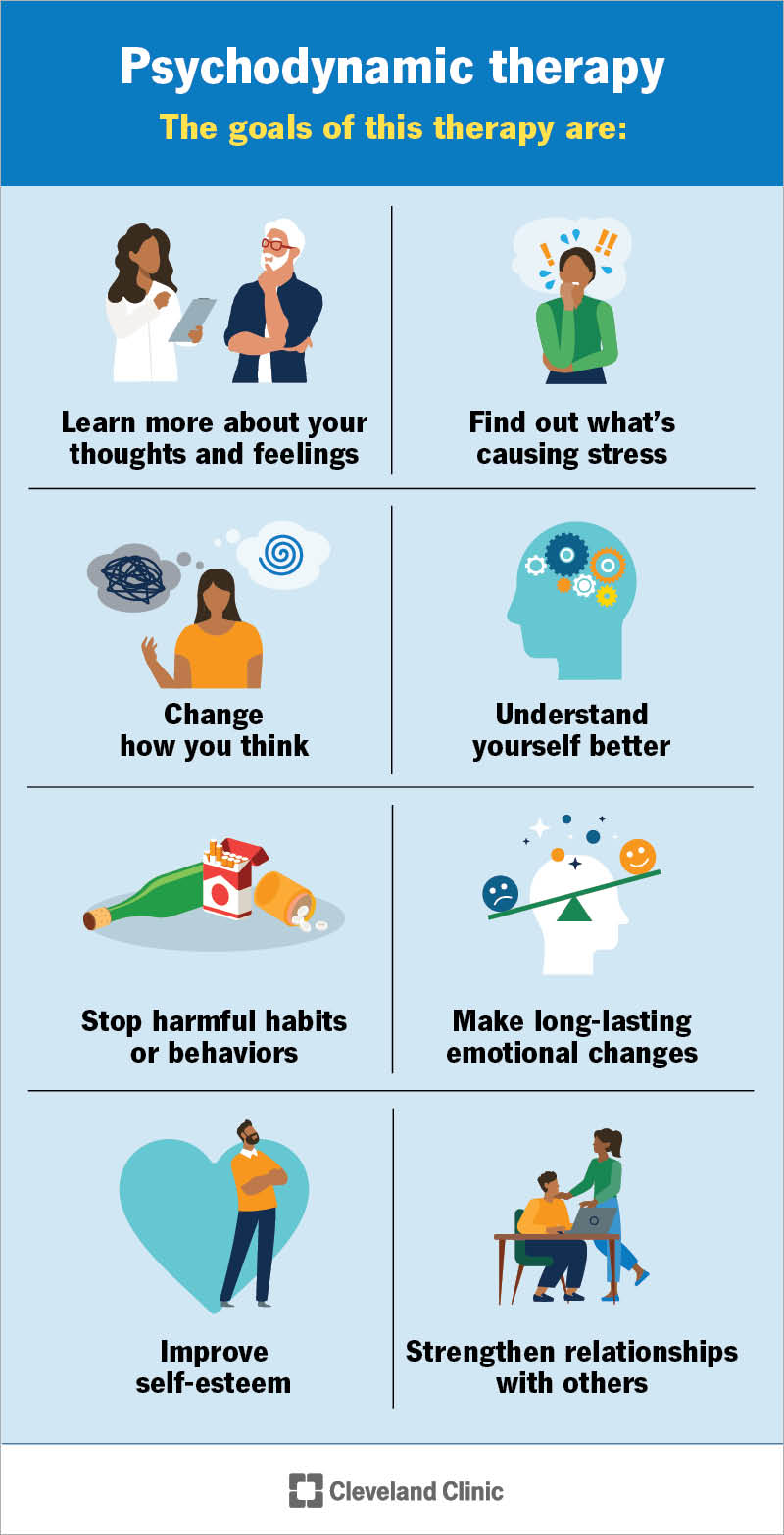Psychodynamic therapy is a talk therapy where you dive into past thoughts and feelings to understand how they shape who you are today. This self-discovery can help you feel more confident, build stronger relationships and manage mental health challenges like depression or personality disorders.
Advertisement
Cleveland Clinic is a non-profit academic medical center. Advertising on our site helps support our mission. We do not endorse non-Cleveland Clinic products or services. Policy

Psychodynamic therapy is a kind of talk therapy (psychotherapy) where you’ll explore your past thoughts, feelings and memories. The goal is to see how these affect your life and personality today.
Advertisement
Cleveland Clinic is a non-profit academic medical center. Advertising on our site helps support our mission. We do not endorse non-Cleveland Clinic products or services. Policy
During therapy, you work on bringing hidden or unconscious thoughts into your awareness. This means you start to understand things about yourself that you didn’t notice before.
The main goal is to help you learn more about who you are and why you act the way you do. This can help you feel better about yourself and improve how you connect with others. It can also help you manage underlying mental health conditions.
This is an effective treatment for many mental health conditions, including but not limited to the following:
It may be used in addition to medications or other types of treatments. It can help anyone at any age, from children to adults.
Before you start therapy, you and your therapist will talk about your personal goals. But in general, the goals of this therapy are:
In therapy, you’ll have open-ended talks with your therapist. You can say whatever comes to your mind. Your therapist listens carefully. They may guide you to explore certain feelings or events.
Advertisement
During these sessions, your therapist will help you:
There are different techniques that you and your therapist will use during each session. You might not hear their names or notice them happening. But they may be part of your work together:
Studies show that psychodynamic therapy can help with many mental health conditions, especially depression and personality disorders. This therapy doesn’t stop symptoms quickly. Instead, it helps you understand deep feelings and solve problems in your life and relationships.
This type of therapy may take longer to get results. But the changes you make can last a long time.
Some mental health conditions might work better with other treatments, like cognitive behavioral therapy (CBT) or a mix of therapy and medications. Your provider will help you choose the best plan so you can see the most success.
Psychodynamic therapy can have many benefits, like helping you:
This type of therapy is known to have long-lasting effects, even after you finish seeing your therapist. The insight you gain in each session can change how you see yourself. This may lead to healthier thoughts and behaviors in the future.
Therapy takes time and effort. Even though it’s a safe treatment, it can make you feel uncomfortable, upset or vulnerable. You might talk about feelings or events that you’ve hidden or tried to forget. It isn’t easy to face them.
Advertisement
Remember, therapy is a safe place. No one will judge you. It’s private and confidential. Your therapist will help you reach your goals. They won’t make you talk about anything unless you feel ready. And when you’re ready, they’ll support you through it.
It’s important to work with a therapist you trust. If you don’t feel comfortable sharing your feelings, it’s OK to find a different therapist. Your therapist won’t be upset if you choose someone else. They want you to get the help that works best for you.
At the same time, it’s important to learn to use the skills you gain in therapy on your own. There’s a risk of becoming too dependent on your therapist. This means you might rely on them too much instead of finding new ways to handle problems by yourself. Your therapist will help you build confidence so you can manage tough situations on your own in the future.
Psychodynamic therapy can be short term or long term. Most people meet with their therapist once or twice a week. Each session lasts about an hour. You might continue therapy for a few months or even several years.
There’s no set amount of time that works for everyone. How long you stay in therapy depends on your needs and goals.
Advertisement
Psychologists who studied psychodynamic theories said that thoughts, feelings and actions today are shaped by things you don’t actively think about. These are unconscious thoughts. They come from experiences and relationships you had when you were younger. Sometimes, you push feelings or memories away because they’re too hard to face. But they still affect how you act now.
This idea helps explain why you might repeat certain behaviors or have unexpected, strong emotions. In therapy, talking about these hidden thoughts and past experiences helps you understand yourself better and make healthier choices.
Starting therapy, especially one that looks deep into your past, is like finding a locked box hidden under your bed. You might have lost the key years ago, but inside are memories that can help you heal.
Your therapist will help you find a new way to open this box. Together, you’ll look at the memories inside. It might feel hard sometimes, but you can go as slowly as you need. You don’t have to share everything on the first day.
Psychodynamic therapy is a long-term treatment. If you stick with it, the positive changes can last a long time, too. If you’re considering this kind of therapy, there are a lot of factors to consider. A therapist can answer any question you might have.
Advertisement
Your mental well-being is just as important as your physical well-being. Cleveland Clinic’s mental health experts can help you live life to the fullest.

Last reviewed on 10/06/2025.
Learn more about the Health Library and our editorial process.